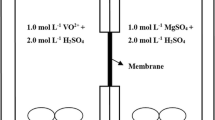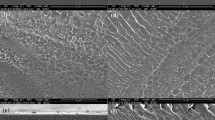Abstract
In this work, the polyvinyl pyrrolidone (PVP) was blended with the material of polyvinylidene fluoride modified by imidazolium ionic liquid (PVDF-IL) and finally a kind of porous PVDF-IL-PVP composite membrane was successfully prepared after membrane casting and ethanol treatment. The porous structure of the membranes was evaluated by SEM in detail and the existence of PVP was also proved by FTIR results. Combining with the porous structure and the addition of PVP, the water uptake and acid uptake of the membranes were improved a lot which greatly promoted the affinity between the electrolytes and the membranes. The properties of the PVDF-IL-PVP membranes were investigated systematically. The modified membranes showed a great increment in ion conductivity. Additionally, the vanadium permeabilities of PVDF-IL-PVP20 and PVDF-IL-PVP30 membranes were also lower than that of Nafion115. At the current density of 100 mA/cm2, the battery assembled with the PVDF-IL-PVP30 membrane exhibited higher Coulombic efficiency (97.82% vs. 97.29%), voltage efficiency (85.17% vs. 82.30%), and energy efficiency (83.31% vs. 80.07%) compared to Nafion115, in conjunction with excellent cycle stability in vanadium redox flow batteries (VRFBs). In conclusion, this work provides a kind of well-performed membrane that has great potential for the application in VRFBs.










Similar content being viewed by others
Data availability
The data that support the findings of this study are available from the corresponding author upon reasonable request.
References
Bamati N, Raoofi A (2020) Development level and the impact of technological factor on renewable energy production. Renew Energy 151:946–955. https://doi.org/10.1016/j.renene.2019.11.098
Ma Y, Yang P, Zhou X, Gao Z. in 2016 IEEE International Conference on Mechatronics and Automation. 159–164
Arévalo-Cid P, Dias P, Mendes A, Azevedo J (2021) Redox flow batteries: a new frontier on energy storage. Sustain Energy Fuels 5:5366–5419. https://doi.org/10.1039/d1se00839k
Ulaganathan M et al (2016) Recent advancements in all-vanadium redox flow batteries. Adv Mater Interfaces 3. https://doi.org/10.1002/admi.201500309
Thiam BG, Vaudreuil S (2021) Review—recent membranes for vanadium redox flow batteries. J Electrochem Soc 168. https://doi.org/10.1149/1945-7111/ac163c
Jiang B, Wu L, Yu L, Qiu X, Xi J (2016) A comparative study of Nafion series membranes for vanadium redox flow batteries. J Membr Sci 510:18–26. https://doi.org/10.1016/j.memsci.2016.03.007
Xing Y et al (2021) Chemically stable anion exchange membranes based on C2-protected imidazolium cations for vanadium flow battery. J Membr Sci 618:118696. https://doi.org/10.1016/j.memsci.2020.118696
Chen Y, Li Y, Xu J, Chen S, Chen D (2021) Densely quaternized fluorinated poly(fluorenyl ether)s with excellent conductivity and stability for vanadium redox flow batteries. ACS Appl Mater Interfaces 13:18923–18933. https://doi.org/10.1021/acsami.1c04250
Qiu J et al (2007) Preparation of ETFE-based anion exchange membrane to reduce permeability of vanadium ions in vanadium redox battery. J Membr Sci 297:174–180. https://doi.org/10.1016/j.memsci.2007.03.042
Liu F et al (2017) Polybenzimidazole/ionic-liquid-functional silica composite membranes with improved proton conductivity for high temperature proton exchange membrane fuel cells. J Membr Sci 541:492–499. https://doi.org/10.1016/j.memsci.2017.07.026
Li Q, Jensen JO, Savinell RF, Bjerrum NJ (2009) High temperature proton exchange membranes based on polybenzimidazoles for fuel cells. Prog Polym Sci 34:449–477. https://doi.org/10.1016/j.progpolymsci.2008.12.003
Yang J et al (2013) Crosslinked hexafluoropropylidene polybenzimidazole membranes with chloromethyl polysulfone for fuel cell applications. Adv Energy Mater 3:622–630. https://doi.org/10.1002/aenm.201200710
Zhou J et al (2021) Highly conductive and vanadium sieving microporous Tröger’s base membranes for vanadium redox flow battery. J Membr Sci 620. https://doi.org/10.1016/j.memsci.2020.118832
Devrim Y, BulanıkDurmuş GN (2022) Composite membrane by incorporating sulfonated graphene oxide in polybenzimidazole for high temperature proton exchange membrane fuel cells. Int J Hydrogen Energy 47:9004–9017. https://doi.org/10.1016/j.ijhydene.2021.12.257
Guo Z, Xu X, Xiang Y, Lu S, Jiang SP (2015) New anhydrous proton exchange membranes for high-temperature fuel cells based on PVDF–PVP blended polymers. J Mater Chem A 3:148–155. https://doi.org/10.1039/c4ta04952g
Chen F et al (2020) Polybenzimidazole and polyvinylpyrrolidone blend membranes for vanadium flow battery. J Electrochem Soc 167. https://doi.org/10.1149/1945-7111/ab823a
Wu L et al (2009) Hydrogen bonding: a channel for protons to transfer through acid−base pairs. J Phys Chem B 113:12265–12270. https://doi.org/10.1021/jp905778t
Matsuyama H, Maki T, Teramoto M, Kobayashi K (2003) Effect of PVP additive on porous polysulfone membrane formation by immersion precipitation method. Sep Sci Technol 38:3449–3458. https://doi.org/10.1081/ss-120023408
Li Y, Zhang H, Li X, Zhang H, Wei W (2013) Porous poly (ether sulfone) membranes with tunable morphology: fabrication and their application for vanadium flow battery. J Power Sources 233:202–208. https://doi.org/10.1016/j.jpowsour.2013.01.088
Ge L et al (2015) Preparation of proton selective membranes through constructing H+ transfer channels by acid–base pairs. J Membr Sci 475:273–280. https://doi.org/10.1016/j.memsci.2014.10.039
Wang Z, Jiang J, Dong Z, Song Y, Zhao L (2023) Radiation synthesis of imidazolium ionic liquid grafted PVDF as anion exchange membrane for vanadium redox flow battery. New J Chem. https://doi.org/10.1039/d2nj05386a
Pu H, Liu Q, Qiao L, Yang Z (2005) Studies on proton conductivity of acid doped polybenzimidazole/polyimide and polybenzimidazole/polyvinylpyrrolidone blends. Polym Eng Sci 45:1395–1400. https://doi.org/10.1002/pen.20394
Hu G et al (2012) A novel amphoteric ion exchange membrane synthesized by radiation-induced grafting α-methylstyrene and N, N-dimethylaminoethyl methacrylate for vanadium redox flow battery application. J Membr Sci 407–408:184–192. https://doi.org/10.1016/j.memsci.2012.03.042
Che X et al (2020) Porous polybenzimidazole membranes with high ion selectivity for the vanadium redox flow battery. J Membr Sci 611. https://doi.org/10.1016/j.memsci.2020.118359
Xing C et al (2015) Immobilization of ionic liquids onto the poly(vinylidene fluoride) by electron beam irradiation. Ind Eng Chem Res 54:9351–9359. https://doi.org/10.1021/acs.iecr.5b02819
Cui Z, Drioli E, Lee YM (2014) Recent progress in fluoropolymers for membranes. Prog Polym Sci 39:164–198. https://doi.org/10.1016/j.progpolymsci.2013.07.008
Dalian Rongke Energy Storage Technology Development Co., L., Dalian Institute of Chemical Physics, C. A. o. S. & Industry, B. I. o. E. T. a. E. o. M. Vol. GB/T 32509–2016 16 (General Administration of Quality Supervision, Inspection and Quarantine of the People’s Republic of China; Standardization Administration of China, 2016)
Kabir L, Paul S, Choi S-J, Kim HJ (2020) Improved electrochemical and mechanical properties of poly (vinylpyrrolidone)/Nafion® membrane for fuel cell applications. J Nanosci Nanotechnol 20:7793–7799
Acknowledgements
The authors would also like to thank the Analysis and Testing Center of Huazhong University of Science and Technology for its technical support. Besides, this research did not receive any specific grant from funding agencies in the public, commercial, or not-for-profit sectors.
Author information
Authors and Affiliations
Contributions
Zhiguo Wang and Yifei Song: conceptualization, data curation, writing—original draft, and methodology. Jiali Jiang, Wenchao Zhao, Manman Zhang, Zhen Dong, and Long Zhao: writing-review and editing, and supervision. All authors read and approved the final manuscript.
Corresponding author
Ethics declarations
Ethical approval
Not applicable.
Competing interests
The authors declare no competing interests.
Additional information
Publisher's Note
Springer Nature remains neutral with regard to jurisdictional claims in published maps and institutional affiliations.
Supplementary Information
Below is the link to the electronic supplementary material.
Rights and permissions
Springer Nature or its licensor (e.g. a society or other partner) holds exclusive rights to this article under a publishing agreement with the author(s) or other rightsholder(s); author self-archiving of the accepted manuscript version of this article is solely governed by the terms of such publishing agreement and applicable law.
About this article
Cite this article
Wang, Z., Song, Y., Jiang, J. et al. Promoting ion conductivity of imidazolium grafted PVDF membranes through blending PVP for vanadium redox flow batteries. Ionics 30, 901–911 (2024). https://doi.org/10.1007/s11581-023-05342-y
Received:
Revised:
Accepted:
Published:
Issue Date:
DOI: https://doi.org/10.1007/s11581-023-05342-y




